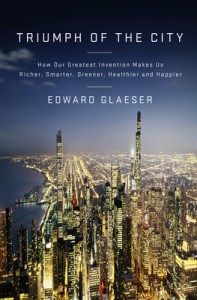 Edward Glaeser.“If ideas are the currency of our age, then building the right homes for those ideas will determine our collective fate.”
Edward Glaeser.“If ideas are the currency of our age, then building the right homes for those ideas will determine our collective fate.”
That’s what Harvard economist and New York Times columnist Edward Glaeser writes in his new book, Triumph of the City: How Our Greatest Invention Makes Us Richer, Smarter, Greener, Healthier, and Happier.
And as you might be able to tell from the title, Glaeser thinks that the “right home for ideas” is cities. And he doesn’t think that any amount of internet connectivity can diminish the importance of face-to-face contact when it comes to fostering human innovation. He also thinks the United States needs to rethink policies — like the mortgage tax credit and subsidies for highways — that encourage sprawl.
In his book, Glaeser looks at cities as diverse as Bangalore and Houston, but saves a lot of his love for his native New York. He holds it up as an example of a city that reinvented itself when so many other cold northern cities in the United States were on the decline. Glaeser credits New York’s entrepreneurial spirit, fostered by a traditionally diverse economy. He contrasts that to the auto-based monoculture of Detroit, which he argues quashed the creativity a city needs to adapt and survive.
We talked last week about how environmentalists in California unwittingly cause sprawl in the Sun Belt, about the history of anti-urbanism in the United States, and about why we should focus on making drivers pay for the environmental damage they do before we go nuts building high-speed rail. He also copped to living in the suburbs himself.
Q. Talk to me about the idea in your title — “the triumph of the city.” As much as you make a great case for what is successful about cities, at the same time, in our own country, there is the triumph of sprawl — which you also talk about at some length — and the decline of so many cities. Why do you think that, in the end, cities are triumphing, or on the rise, or will prevail?
A. “The triumph of the city” refers to what happened in the U.S. in terms of the comeback of places like New York and Boston and Minneapolis and Chicago. There’s no denying that the four fastest-growing metropolitan areas of the past 10 years have been Atlanta, Dallas, Houston, and Phoenix. There has been tremendous growth in low-density, car-based living, particularly in the Sun Belt. But those older cities have, in fact, triumphed, in the sense that they are no longer relics that are headed for the trash heaps of history. They are thriving, they are enormously economically productive. These places have once again become the economic core of the country, even if they aren’t adding the largest number of people.
At a global level, the world is moving enormously quickly towards urban living. From an Indian, from a Chinese, from an African perspective, urban life has become increasingly the norm.
Q. In the United States, there is such a bias against cities among certain politicians and structurally in our system, going way back. You talk about Thomas Jefferson and his bias against cities. Why there is this persistent American idea that somehow cities aren’t where the true American spirit resides?
A. Certainly I don’t think that’s accurate. Certainly I think that the founding moments in this country’s history, many of them took place in cities. The American Revolution had its roots in the urban conflict between John Hancock, Sam Adams, John Adams, and the British. Cities brought together the early activists that made the Revolution, enabled the exchange of ideas that lay at the very heart of the founding of our country. A large number of our founding fathers were deeply urban people. Alexander Hamilton was very much a child of New York. Benjamin Franklin was the most urban founding father.
I’m an economist, right? So I don’t naturally see that it’s my business to advocate for a particular lifestyle. People choose to live in whatever type they want to live and that’s fine. But there’s certainly nothing un-American about living in a city. An urban apartment can be just as much of an American dream as living in a low-density suburb.
The policy implication that I do care deeply about is not necessarily to change lifestyles, but to change policies that bias people to live outside of cities. Policies that encourage people to move from urban apartments to single-family detached homes. We make such a fetish of home ownership. The highways that enable people, including myself, to commute to work by car over long distances instead of living close to the urban core. Those policies are all deeply hobbling.
The decision not to take appropriate steps to charge people for their carbon emissions is also, in a sense, a bias against cities. In fact, people should be paying for the environmental costs of their actions. That certainly means that we’re currently under-pricing the high carbon emissions involved in low-density living.
How did we get there? Why is it that living in low-density sprawl, suburbs, small towns, is the love of the politicians, and living in cities is not? It’s hard to say.
Even President Obama, who is the most urban president we’ve had since Teddy Roosevelt, in many ways. I didn’t hear any words in the State of the Union about cherishing our cities.
Q. There were absolutely none. He kept his mouth shut about that.
A. I think that’s not because he doesn’t believe in cities. I believe quite strongly that he does. I think he’s recognizing the political reality, which is that somehow that’s seen as being anti-American.
This is a longstanding trend. Teddy Roosevelt was enormously urban. He was one of three heads of the New York City Police Department, for goodness sakes. But Teddy Roosevelt was sold as the Rough Rider, who had lived in the Badlands, not as the child of dense New York who had made his bones in city politics. It’s a remarkable history of turning our back on our past.
The only thing that seems obvious is the fact that we have a Senate that strongly over-represents low-density living. We have a Senate that is highly biased against the places that are highly urbanized and highly dense. Of course, the Electoral College does too.
Q. In your book you talk about how land-use policies, anti-development policies in places like California, are essentially pushing development into the Sun Belt and the Sprawl Belt.
 A. My largest message to the environmental community is to fight development when it’s harmful for the environment, but support development when it’s helpful for the environment. Local activists can’t stop development in the U.S. as a whole. There’s just going to be too many areas where they’re going to be happy to build. We’re going to build, roughly, in the long term, 1.5 million, 1.4 million new housing units a year to accommodate the population growth and the depreciation of old housing. While local activists can’t turn that off, they can determine where it happens, because they can, in their own communities, stop development. When you turn off the flow of new housing in your community, it turns on somewhere else.
A. My largest message to the environmental community is to fight development when it’s harmful for the environment, but support development when it’s helpful for the environment. Local activists can’t stop development in the U.S. as a whole. There’s just going to be too many areas where they’re going to be happy to build. We’re going to build, roughly, in the long term, 1.5 million, 1.4 million new housing units a year to accommodate the population growth and the depreciation of old housing. While local activists can’t turn that off, they can determine where it happens, because they can, in their own communities, stop development. When you turn off the flow of new housing in your community, it turns on somewhere else.
At least one way that we see this is if you think about California’s post-war arc. California through the ’60s was building an enormous amount of housing. Gradually, starting in the ’70s, that growth of new housing diminished sharply, particularly in the most attractive coastal areas of the country. One reason for that slowdown were environmental victories like the Friends of Mammoth case that made it much more difficult to build.
The sad fact from an environmental point of view is that building in the San Francisco Bay is a great thing to do. There’s an incredibly temperate climate, which means that the carbon emissions for households there are among the lowest in the country. It’s got plenty of access to great public transportation. This is the area that should be building a great deal of housing. But when you make it difficult to build there, you make sure that there’s housing being built instead in the suburbs of Houston, where you’d need a lot of energy to create a pleasant manmade environment, and there’s a lot of driving.
Q. On a related note, you talk about how urbanists just love to hate places like Houston, but there’s not really anything to be gained by hating it. Instead, they should try to understand why it is that so many people want to live there.
A. It remains true that the past census that was just released reminds us that Texas is adding an awful lot of people. A lot of people are finding Houston and Dallas very, very attractive. What I try to do in the book is make it clear that from an individual point of view, their preferences are actually pretty rational. If you look at a household earning $70,000 a year in New York, or $60,000 a year in Houston, you can just can afford a lot of house, and get a decent school, and enjoy a decent quality of life in Houston on that kind of money, and you just can’t in New York City. You can’t, really, in most of coastal California, either.
That should lead you to wonder why is it that Houston is able to deliver affordable housing and a decent lifestyle to ordinary Americans in a way that say, my own state of Massachusetts cannot. It’s a sad irony that progressive Massachusetts, that truly believes in providing affordable housing for middle-class Americans, is so bad at it. Whereas Texas, where you hear much less of that, is so good at it. I think the local lesson from this has to do with providing enough housing — with making it possible for private builders to craft enough units so that people can actually afford to live in the place, so these places don’t become boutique cities that are only affordable by the very wealthy.
You want to learn from Houston, you don’t want to hate Houston.
Q. Without policies changing — like the mortgage tax deduction, the subsidization of highways, the refusal to raise the gas tax or tax carbon in any form — can the kinds of reforms that you talk about ever become reality?
A. I don’t know. Obviously the carbon tax, gas tax, is a heavy political lift. I’m not ready to write that one off, but it’s certainly hard. On home mortgage interest deduction, I was encouraged that the Bowles-Simpson tax plan really did put that on the table, at least lowering the upper limit, lowering the cap from a million to $500,000 with one plan. I think in this world of radical rethinking of deficit-related issues, I think the mortgage interest deduction is on the table, and it’s the right time to push for it.
One way to think about this is we’ve never been at a point where it is so obvious that having a government policy that encourages people to leverage themselves to the hilt, to bet on the vicissitudes of the housing market, it’s never been so obvious that this is a silly policy. This is basically what we do. I’m not saying that the government caused the housing bubble. I’m just saying that the government policy pushed people to risk everything they have on movements in housing prices. That’s what having a mortgage interest deduction that is tied to the size of your mortgage does.
You’re right that I may be overly optimistic, but if I really thought there was no chance to at least move things along the margins, I doubt I would have written the book, or I certainly wouldn’t have written those sections of the book.
I also think that part of the job of people with job descriptions like myself — we’re not running for any kind of public office, I’m not expecting to get any kind of a job in Washington, I think I’m permanently unappointable because of too many things I’ve said that offend both the right and the left. Part of the job of people like me is to say things that are outside the political mainstream in the hope that in the long run, we’ll actually move away from the view that the white picket fence is the only option for America.
Q. Of course, that is, essentially the life that you live, the white picket fence.
A. Yeah … that’s true.
Q. I commend you for not burying that information.
A. I’m very blessed. I have a very nice house in a very nice community. I would say that I dream of the city every night. I am counting the days until my last child graduates from high school, where I fully plan on living in a very small urban apartment somewhere very dense. I am certainly counting the days, but it’s certainly true that that’s not the life that I’m currently living in. I think part of it is the idea of dealing with three private school tuitions on an academic salary, it was very scary.
Q. So, what about high-speed rail? You seem to be pretty skeptical on that.
A. There’s a general skepticism about infrastructure in the book, relative to education. It’s not that I’m particularly singling out high-speed rail. I’m wary of any very large, very expensive form of physical capital.
I see so much more value in getting the schools straight, and making investments that will have a clear payoff in quality of life relative to spending billions on a tunnel or billions on a rail line. In terms of the history of infrastructure for declining cities, I think it’s a very sad story. We spent a lot of years to right Detroit and Cleveland and neglected the children of these areas. That actually makes me angry. I feel like we did something because our friends in Washington are geared up to spend money on transportation infrastructure rather than to spend money on children. I think we got far too many boondoggles like the people mover in Detroit.
A little bit on high-speed rail per se. I don’t have, and I’ve never had a problem with high-speed rail in the Northeast Corridor. I think that that’s a perfectly sensible thing to do. I just have a lot of trouble seeing how high-speed rail is going to work in these whole vast regions of the country that were built around the car. You can say, and I’ve certainly heard this hope, that high-speed rail will just cause people to shift toward higher-density living. It’ll be a minor impact on that, but it feels very minor to me relative to the cost. It feels like you’re betting on high-speed rail in order to hope that something like that will occur.
If what you really want to do is encourage higher-density living in the Sun Belt, in the car-based areas of this country, let’s just start with a carbon tax on driving. Before we put down the vast amount of infrastructure at the cost of 10 or 20 billion dollars, let’s just start by actually charging people for the social costs of their actions. The tax is actually going to raise revenue, and it’s also going to push people toward higher-density living.
Q. You talk about all the factors, like the mortgage tax deduction, that are not just facilitating sprawl, but really, pushing people into living in sprawl. Yet now, there’s this perception that when the Obama administration is doing anything to create better conditions in cities, that that is coercion. There’s a lot of talk on the very far right that we’re being pushed to live in cities. Where is that perception coming from?
A. It gets back to your first question, why have cities fared so poorly in the political discourse over the past 200 years? The truth of the matter is that I think that the Obama administration is simply trying to give us a level playing field. It needs to be presented as that. To those Republicans, to those Tea Party activists who believe in the home mortgage interest deduction: Shouldn’t the U.S. government stop engaging in social engineering? Shouldn’t the U.S. government stop engaging in those policies that artificially push people out of the homes that they would have? Haven’t we had enough of activist government trying to shoehorn us into low-density living?
That’s how I try to present it, and I actually believe that. I have some libertarian bent. I think that things are problematic in part because they impinge on basic human freedom, the ability to choose cities if you want to choose cities. Given how anti-urban the broad spectrum of public policy is, if anyone attempts to depict the tiny things that are slightly pro-urban as being an attempt to socially engineer Americans into cities, I find that quite odd.
Q. It is odd, but there’s a lot that’s very odd out there. I’m wondering if it then goes back to the beautiful things that you talk about at the beginning of the book — the great advantages of cities, the creation of ideas, the creation of knowledge, the creation of a broadly educated citizenry. If the anti-urban bias maybe goes hand in hand with that bias that we see against education and intellectualism.
A. I can think of nothing more dangerous to America’s future to take the idea that skills and education are dangerous. There’s nothing that the long-run future of this country depends upon more than the knowledge that is in its citizens’ heads. We need to cherish that knowledge, and cherish those things that actually create that knowledge, and create the new innovations. Cities are part of that.




